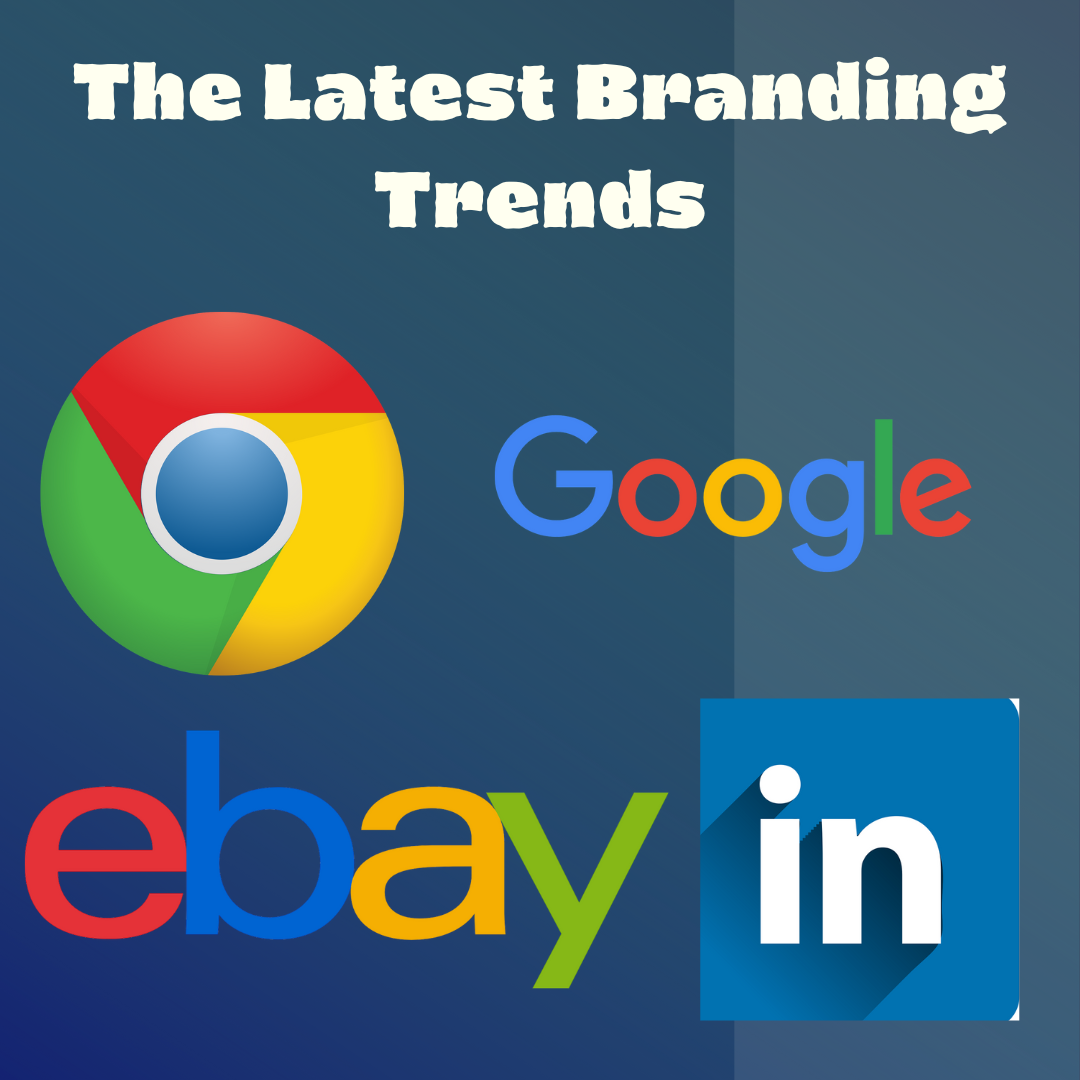
The Latest Branding Trends
The Latest Branding Trends You Need To Know. Here are some of the latest branding trends
The Latest Branding Trends – Minimalism
Brands are adopting a more stripped-back and simple approach to their branding, with clean and minimalistic designs.
Minimalism is a design philosophy that emphasizes the use of minimal elements and a simple, uncluttered aesthetic. In recent years, this philosophy has become increasingly popular in branding and marketing, as brands look to create a more modern and sophisticated image.
A minimalist approach to branding involves simplifying the visual elements of a brand, such as the logo, typography, and color palette. This can involve using simple, geometric shapes, reducing the number of colors used, and choosing a clean, legible font. By simplifying these elements, brands can create a more timeless and versatile brand identity that can adapt to changing trends and consumer preferences.
Minimalist branding is often associated with luxury and high-end products, as it suggests a sense of sophistication and elegance. It can also be used to convey a sense of authenticity and honesty, as minimalistic designs suggest that a brand is confident enough in its products or services to let them speak for themselves, rather than relying on flashy or gimmicky branding.
Overall, minimalism in branding is about using less to say more. By stripping away unnecessary elements and focusing on the essential qualities of a brand, minimalist designs can create a powerful and enduring brand identity that resonates with consumers.

The Latest Branding Trends – Bold typography
Brands are using typography to make a statement and stand out, with bold and eye-catching fonts that demand attention.
Typography refers to the style and arrangement of text, including the choice of font, size, spacing, and color. In recent years, many brands have been using bold typography as a way to create a distinctive and memorable brand identity.
Bold typography involves using fonts that are large, heavy, and attention-grabbing. These fonts are often used in conjunction with simple, minimalistic designs to create a powerful visual impact. By using bold typography, brands can communicate a sense of confidence and authority, while also making their message clear and easy to read.
One of the benefits of bold typography is that it can help a brand stand out in a crowded marketplace. In a world where consumers are constantly bombarded with advertising messages, a bold font can help a brand cut through the noise and grab the attention of potential customers. This is particularly important in digital marketing, where brands are competing for limited attention spans on social media and other online platforms.
Bold typography can also be used to convey a sense of personality and style. Different fonts have different connotations and associations, and by choosing a particular font, a brand can communicate a specific tone or mood. For example, a brand that uses a bold, sans-serif font may be seen as modern and forward-thinking, while a brand that uses a more traditional serif font may be seen as classic and timeless.
Overall, bold typography is a powerful tool that brands can use to create a distinctive and memorable brand identity. By using a strong, attention-grabbing font, brands can make a statement and stand out in a crowded marketplace, while also communicating a sense of confidence, authority, and personality.
The Latest Branding Trends – Authenticity
Consumers are looking for authentic brands that are transparent about their values and purpose, and are willing to engage with them on a personal level.
Authenticity has become a key value for consumers when it comes to choosing brands and products. In recent years, consumers have become increasingly aware of the impact that their purchasing decisions can have on the world, and they are looking for brands that they can trust to be honest, transparent, and socially responsible.
An authentic brand is one that is true to its values, mission, and purpose. It is a brand that is transparent about its business practices, and is willing to engage with customers on a personal level. Authentic brands are built on a foundation of trust, and they work to establish long-term relationships with their customers based on mutual respect and shared values.
Consumers are attracted to authentic brands because they want to feel good about the products and services that they buy. They want to know that the brands they support are doing good in the world, and that they are making a positive difference in the lives of their customers, their employees, and the community at large.
Authenticity can be demonstrated in a number of ways. One way is by being transparent about the brand’s sourcing and manufacturing practices, and by providing customers with information about the materials and processes that go into making their products. Another way is by engaging with customers on a personal level, and by creating a sense of community around the brand.
Overall, authenticity is about building trust and creating meaningful connections with customers. By being honest, transparent, and socially responsible, brands can establish themselves as leaders in their industries, and build a loyal customer base that will support them for years to come.
The Latest Branding Trends – Storytelling
Brands are using storytelling to create emotional connections with their audiences, sharing their brand history, values, and vision to create a sense of identity and purpose.
Storytelling has become an increasingly important part of branding and marketing in recent years. By using stories to connect with their audiences, brands are able to create emotional connections, build loyalty, and establish a sense of identity and purpose.
The power of storytelling lies in its ability to create a narrative that resonates with the audience. By sharing their brand history, values, and vision, brands can create a sense of identity that goes beyond their products or services. This can help them stand out in a crowded marketplace, and build long-term relationships with their customers.
A strong brand story can take many forms. It can be a simple narrative that explains the origins of the brand, or a more complex story that explores the brand’s values and mission. It can be told through video, social media, or other digital platforms, or through more traditional channels such as print or television advertising.
The key to successful brand storytelling is authenticity. Consumers are looking for brands that are honest, transparent, and true to their values. A brand story that feels contrived or insincere is unlikely to resonate with audiences, and may even damage the brand’s reputation.
By using storytelling to create emotional connections with their audiences, brands can establish themselves as more than just a provider of products or services. They can become a part of their customers’ lives, and build a sense of loyalty and community around their brand. This can ultimately lead to increased sales, brand recognition, and customer engagement, as well as a more meaningful and fulfilling relationship between the brand and its audience.

The Latest Branding Trends – Interactive branding
Brands are creating interactive experiences that engage with customers in new and innovative ways, from immersive pop-up stores to digital experiences.
Interactive branding is an emerging trend in marketing that involves creating experiences that engage customers in new and innovative ways. Brands are looking for ways to stand out in a crowded marketplace and create memorable experiences that build brand loyalty and drive sales.
One of the most popular ways that brands are creating interactive experiences is through pop-up stores. These temporary retail spaces are designed to be immersive, interactive, and engaging, with unique designs and installations that are meant to surprise and delight customers. Pop-up stores can be found in a variety of locations, from shopping malls to city centers, and are often used to promote new products or collections.
Another way that brands are creating interactive experiences is through digital platforms. Brands are using social media, mobile apps, and other digital channels to engage with customers and create personalized experiences. For example, some brands are using augmented reality to allow customers to try on clothes or see how furniture would look in their homes. Others are using chatbots to provide customer service and support.
In addition to pop-up stores and digital experiences, brands are also creating interactive experiences through events and activations. For example, some brands are hosting experiential events where customers can try new products, attend workshops, or meet with influencers. Others are creating installations or displays that are meant to be interactive and shareable on social media.
The goal of interactive branding is to create experiences that are memorable, shareable, and build brand loyalty. By engaging with customers in new and innovative ways, brands can establish themselves as leaders in their industries and build long-term relationships with their customers. Interactive branding also allows brands to stand out in a crowded marketplace, and create experiences that are truly unique and memorable.
The Latest Branding Trends – Personalization
Brands are using data and technology to create personalized experiences that are tailored to the individual customer, from personalized product recommendations to customized marketing messages.
Personalization is a marketing trend that involves tailoring experiences and content to the individual customer. By leveraging data and technology, brands are able to create experiences that are customized to the unique preferences and needs of each customer.
Personalization can take many forms. For example, brands may use customer data to create personalized product recommendations, or to offer discounts and promotions based on past purchase history. They may also use customer data to create customized marketing messages that are targeted to specific demographics or interests.
One of the most common ways that brands personalize experiences is through digital channels, such as websites and mobile apps. For example, some brands use cookies and other tracking technologies to personalize website content and navigation based on a customer’s past browsing history or geographic location.
Brands may also personalize experiences through offline channels, such as in-store experiences or customer service interactions. For example, some brands offer personalized styling services or customized product recommendations based on a customer’s preferences and needs.
The benefits of personalization are clear. By tailoring experiences to the individual customer, brands can create more meaningful and engaging interactions that build loyalty and drive sales. Personalization also allows brands to stand out in a crowded marketplace, and to create experiences that are truly unique and memorable.
However, it is important for brands to be transparent and respectful when collecting and using customer data for personalization. Customers may feel uncomfortable if they feel their privacy is being compromised, or if they receive personalized messages that are too intrusive or irrelevant to their needs. Therefore, it is essential for brands to strike a balance between personalization and respect for their customers’ privacy and preferences.
The Latest Branding Trends – Social responsibility

Brands are taking a more socially responsible approach to their branding, with a focus on sustainability, diversity, and inclusion.
Social responsibility is a growing trend in branding, where brands are taking a more active role in addressing social and environmental issues. Consumers are increasingly interested in purchasing products and services from brands that align with their values and take responsibility for their impact on society and the planet.
One key aspect of social responsibility in branding is sustainability. Brands are making efforts to reduce their carbon footprint, minimize waste, and use sustainable materials in their products and packaging. This includes using renewable energy sources, reducing water usage, and implementing recycling programs. Some brands have even gone as far as to become carbon neutral or carbon negative.
Another aspect of social responsibility in branding is diversity and inclusion. Brands are recognizing the importance of representing and catering to a diverse range of people in their products, marketing, and corporate culture. This includes creating more inclusive product lines, featuring diverse models and spokespersons in their advertising, and establishing inclusive hiring and employment practices.
In addition to sustainability and diversity, social responsibility in branding also encompasses issues such as fair labor practices, ethical sourcing, and philanthropy. Brands are taking steps to ensure that their supply chains are free of exploitation and that workers are paid fairly and work under safe conditions. Many brands are also making charitable contributions and partnering with nonprofit organizations to address social and environmental issues.
The benefits of social responsibility in branding are numerous. By taking a socially responsible approach, brands can build trust and loyalty among customers who are increasingly interested in supporting ethical and sustainable businesses. Socially responsible branding can also differentiate brands in a crowded marketplace and attract new customers who share the same values.
However, it is important for brands to ensure that their efforts towards social responsibility are genuine and not just a marketing ploy. Consumers are becoming more discerning and can easily identify brands that are engaging in “greenwashing” or other forms of deceptive marketing. Therefore, it is important for brands to be transparent about their efforts towards social responsibility and to genuinely commit to making a positive impact on society and the planet.
The Latest Branding Trends – Brand partnerships

Brands are collaborating with other brands and influencers to create unique and memorable experiences that help them stand out in a crowded marketplace.
Brand partnerships are a growing trend in marketing and branding, where brands collaborate with other brands or influencers to create unique and memorable experiences for customers. These partnerships can take many forms, from co-branded products and limited-edition collaborations to influencer partnerships and joint marketing campaigns.
One key benefit of brand partnerships is the ability to tap into a new audience or demographic. By collaborating with another brand or influencer, brands can gain exposure to new customers who may not have been aware of their brand before. Additionally, brand partnerships can help to create a sense of excitement and anticipation among existing customers, who are eager to see what new and innovative products or experiences the partnership will create.
Another benefit of brand partnerships is the ability to create a unique and memorable experience for customers. By combining the strengths and expertise of two or more brands, the partnership can create something that is truly unique and memorable. For example, a fashion brand and a tech company might collaborate to create a new line of wearable technology, or a food brand and a celebrity chef might collaborate to create a limited-edition menu or recipe book.
Brand partnerships can also help to build credibility and trust with customers. By collaborating with another brand or influencer, a brand can leverage their partner’s expertise and reputation to enhance their own. This can help to build trust and credibility with customers who may be more likely to trust and purchase from brands that have established partnerships with other respected brands or influencers.
However, it is important for brands to carefully consider the potential risks and drawbacks of brand partnerships. For example, partnerships can be expensive to execute and may require significant resources to manage. Additionally, if the partnership is not carefully aligned with the values and goals of both brands, it may be perceived as inauthentic or disingenuous by customers.
Overall, brand partnerships can be a powerful tool for creating unique and memorable experiences, reaching new audiences, and building credibility and trust with customers. However, brands must carefully consider the potential risks and benefits before entering into a partnership, and ensure that the partnership is aligned with their values and goals.
Apple Revolutionary Glucose Monitor Tech Watch Set to Launch Soon
Habit Hacks: The Art of Building Good Habits and Breaking Bad Ones





